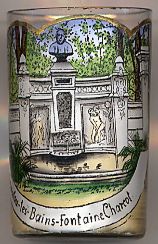

|
| FRANCE | FRANCE |
| région: Occitanie | |
| département: 34, Hérault |
 Lamalou-les-Bains is situated at an elevation of 202 m in the Orb valley of the southern Cévennes mountains,
about 86 km west of Montpellier. Lamalou-les Bains is part of the canton Saint-Gervais-sur-Mare, arrondissement
Béziers in the département Hérault. The municipality has a population of about
2,250 (2007).
Lamalou-les-Bains is situated at an elevation of 202 m in the Orb valley of the southern Cévennes mountains,
about 86 km west of Montpellier. Lamalou-les Bains is part of the canton Saint-Gervais-sur-Mare, arrondissement
Béziers in the département Hérault. The municipality has a population of about
2,250 (2007).
The municipality of Villecelle was created in 1845 out of parts of the municipality of Mourcairol (the remaining part of which was renamed Les Aires).
On 9 September 1878, Villecelle was renamed Lamalou-les-Bains.
The waters, which are both hot and cold, are used in cases of rheumatism, sciatica, locomotor ataxy and nervous maladies.
[Text adapted from http://fr.wikipedia.org/wiki/Lamalou-les-Bains, http://en.wikipedia.org/wiki/Lamalou-les-Bains]
The picture on glass no. 2589 shows a view of the
 Fontaine
Fontaine
[Text adapted from http://www.patrimoine-de-france.org/richesses-53-15374-108886-P59324-266059.html]
Charcot is known as "the founder of modern neurology" and is associated with at least 15 medical eponyms.
Born in Paris, Charcot worked and taught at the famous Salpêtrière Hospital for 33 years. His reputation as an instructor drew students
from all over Europe. In 1882, he established a neurology clinic at Salpêtrière, which was the first of its kind in Europe.
Charcot's primary focus was neurology. He named and was the first to describe multiple sclerosis. He was also the first to describe a disorder known as Charcot joint
or Charcot arthropathy, a degeneration of joint surfaces resulting from loss of proprioception. He researched the functions of different parts of the brain and the role
of arteries in cerebral hemorrhage. Charcot was among the first to describe Charcot-Marie-Tooth disease (peroneal muscular atrophy).
In 1861 and 1862, Charcot, with Alfred Vulpian, added more symptoms to James Parkinson's clinical description and then subsequently attached the name Parkinson's disease to the syndrome.
Charcot's most enduring work was on hypnosis and hysteria. He believed that hysteria was a neurological disorder caused by hereditary problems in the nervous system.
Charcot is just as famous for his students: Sigmund Freud, Joseph Babinski, Pierre Janet, William James, Pierre Marie, Albert Londe, Charles-Joseph Bouchard,
Georges Gilles de la Tourette, and Alfred Binet. Charcot bestowed the eponym for Tourette syndrome in honor of his student, Georges Gilles de la Tourette.
[Text adapted from http://en.wikipedia.org/wiki/Jean-Martin_Charcot]
![[scale]](lineal.jpg)